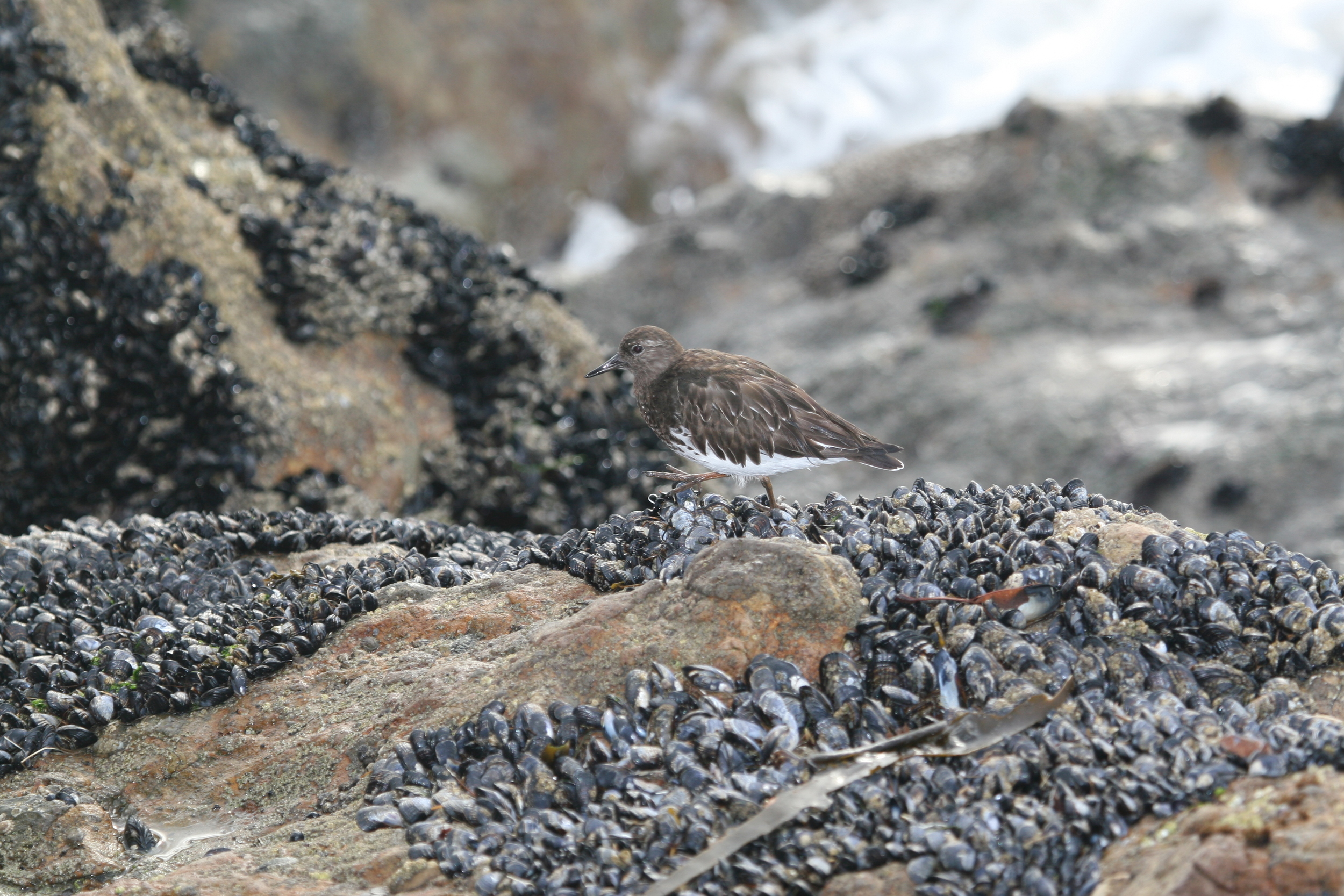Continuing my blog-journey through all the waders I have seen around the world. Buckle up — there are some belters in this part!
054 Hooded Dotterel Thinornis cucullatus
Formerly Charadrius so just missed out on inclusion in the last installment, instead Hoodie becomes first cab of the rank for this part of the blog. I prefer the alternative name of Hooded Plover to the IOC name of dotterel, and this also seems to be the name most Aussies use.
Soon after arriving in Australia I was invited to give a talk at a NICTA retreat at ANU’s “coastal campus”. The University owns a farm that nestles between the beach and State Forest (temperate rain-forest) and is used for academic events like summer schools and retreats. My colleague Richard who’d helped engineer the invitation advertised that the beach was known to have breeding Hooded Plover. These sweet birds nest on Australia’s southern beaches and so in many – even most – areas, compete with people, f*%$ing dogs, and even racehorses for the beach. As a result they are now endangered in NSW, Vic and SA.
Kioloa Beach is big and less populated than many, and there are locals that keep vigil during breeding season so the Hoodies are still breeding there. I managed some nice encounters and even photos of adults and chicks in January 2013. In SA I have seen them on Kangaroo Island, and on the Yorke Peninsula. They have even tried to breed on local Adelaide beaches. In 2018 at Seacliffe a pair hatched three eggs, but one chick was killed by a dog, and the other two taken by gulls while the parents attended to dogs off the lead. Despite rules and prominent signage some wankers just don’t give a f*&k – I am reminded of the Bruce Coburn song, If I had Rocket Launcher.
The image here is from October 2017 when I went camping with girls to Innes National Park at the southern tip of the Yorke Peninsula. Pondalowie Beach nest to our campsite is simply stunning and even better because I found AA and AJ there.

055 Black-fronted Dotterel
A widespread wader of the fringes of freshwater lakes throughout Australia. I most commonly see these at Laratinga Wetlands, and once or twice have spent some time to try to get good images (not as successfully as I would like, as you can see).

056 Diademed Sandpiper-plover Phegornis mitchellii
Up there with Spoon-billed Sandpiper, Ibisbill and Egyptian Plover vying for best wader IMO. It’s not just that Diademed Sandpiper-plover looks fantastic, with its diadem – the white tiara on its crown – and chestnut collar, but the fact that it chooses to live amongst stunning high-Andean scenery that is both spectacular and not-so-easy to get to, that make this one of the world’s top and most desirable birds. This taxon went straight to the top of my target list when I realised I would have a chance to do some birding near Santiago either end of the 2015 International Conference on Computer Vision. The full tale is in my trip report: Chile 2015
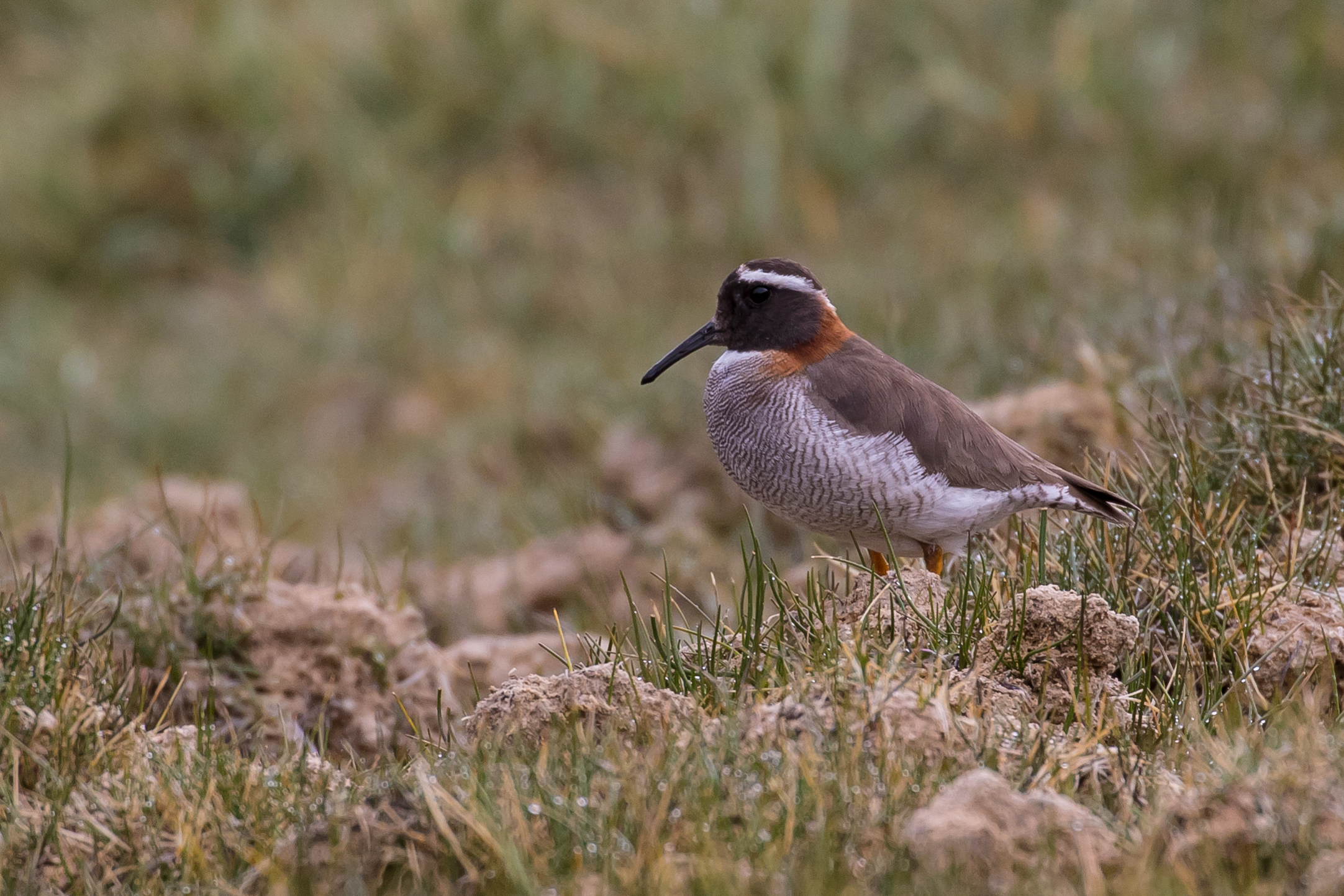
057 Greater Painted Snipe Rostratula benghalensis
As we wound down from some hard-core, sweaty and uncomfortable forest birding on Palawan (this was 2010 — see also 046 Malaysian Plover), our final afternoon was spend chilling, beers in hand, on the deck of a rustic but lovely resort. As we chilled, our intrepid tour guide Rob donned wellies and trudged into the local marsh. Soon after a couple of Greater Painted Snipe flushed out of the reed-bed for flight views. Memorable more for the occasion that the bird or the (lack of) quality views. Ticked, but it would be nice to see one properly some time or bag a pic!
058 Australian Painted Snipe Rostratula australis
Seeing a bird after a long period of wanting to see it, and dipping on various occasions almost always makes the experience when you do connect even sweeter. Australian Painted Snipe was one of my key targets after our arrival (back) to Australia in late 2012. They are scarce and nomadic. I bypassed a twitchable bird in Canberra, Dec 2013 because I had more pressing targets (though friends of mine did get this bird). Then when four showed up at a local Adelaide wetland in 2014, I was away for the entire period of their residence. Two years later a long-staying pair just outside Canberra seemed to provide the chance of a twitch, but they disappeared just a couple of days before my scheduled work trip to the capital and I dipped. It was looking like I would miss out again in 2017 when 3 females and a male were found at a scruffy wetland just north of Adelaide but I was in Sydney with Nikki (seeing Adam and the Ants perform Kings of the Wild Frontier live for her 50th). We got back to Adelaide late Sunday afternoon and, having built up quite a lot of credit for the birthday holiday in Sydney, I spent all my credit jumping into the car as soon as we were back from the airport and headed to Whites Rd. Fortunately the birds were still there. A week later they were still there and Paul, Sam and I managed to add them to our Twitchathon tally. I have not seen one since, nor have I even heard of any being found in SA since then.

059 Comb-crested Jacana Irediparra gallinacea
This shite photo was taken hanging out the window of our overcrowded 4×4 in Madang, en route to Keki Lodge and an appointment with Fire-maned Bowerbird. Some people will tell you a tick’s a tick. Yeah, nah! Not much more to see here; moving on…

060 Pheasant-tailed Jacana Hydrophasianus chirurgus
A superb looking bird in breeding plumage – apparently. At the end of a superb wader-fest of 24 hours in the Gulf of Thailand with Steve Young in 2014, we picked up both non-breeding PTJ (so no pheasant-tails) and Bronze-winged Jacana. Our wader count was 37 species – great birding. This was one of only two lifers for me (both jacanas), while Youngster was able to claw back some iconic critically endangered waders that I had previously gripped him with on a conference stopover a few years earlier.
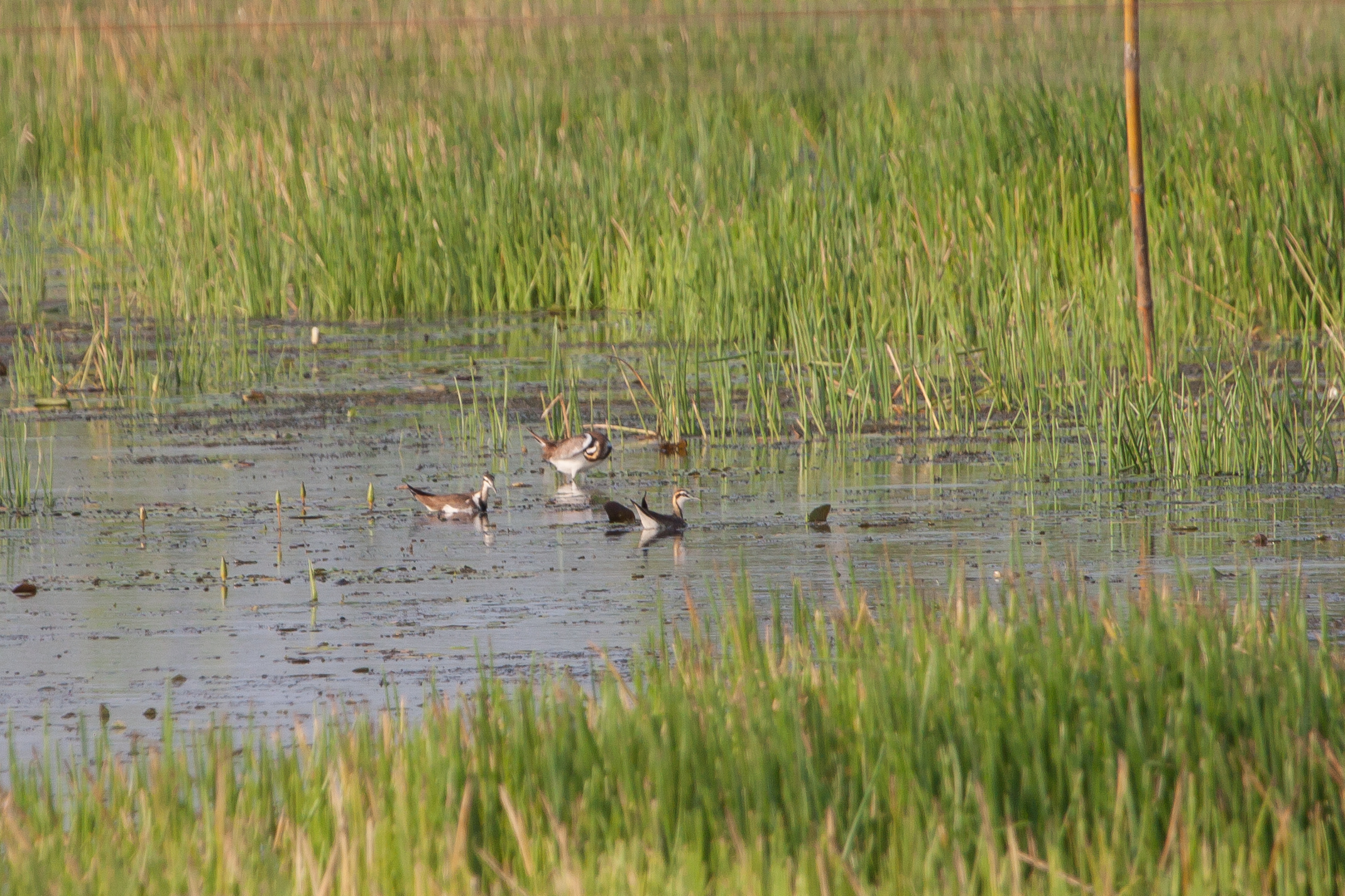
061 Bronze-winged Jacana Metopidius indicus
See 060. Jacanas are nice enough, but for some reason just don’t do it for me. Nuff said.

062 Wattled Jacana Jacana jacana
So you already know that that Jacanas don’t get me going for some reason. But my first of the family came in fabulous circumstances on my first foreign birding away from “home” (i.e. Australia or UK/Europe). The first two days of my conference trip in 2007 were spent at REGUA: Reserva Ecologica de Guapiacu, a wetland and forest regeneration project about 3 hours from Rio in Brazil’s endangered Altantic Rainforest. I was desperately inexperienced in world birding, and under-cooked in terms of preparation, but I had a great two days walking the trails up into the forest and around the restored wetland. Two major regrets from that trip: I failed to find a Shrike-like Cotinga (I found out later a walk of an extra 200m beyond the further point along the waterfall trail would have given me a shot at a breeding bird); and I didn’t go out at night looking for Giant Snipe: rookie error. But in my defence I was having a rather nice time drinking Caipirinhas. Wattled Jacana was just one of 100 or so lifers I had in 2 days. The birds pictured are actually in Venezuela, a brief stopover at a small roadside pond en route to Imataca Forest and a date with one of the world’s most impressive eagles.
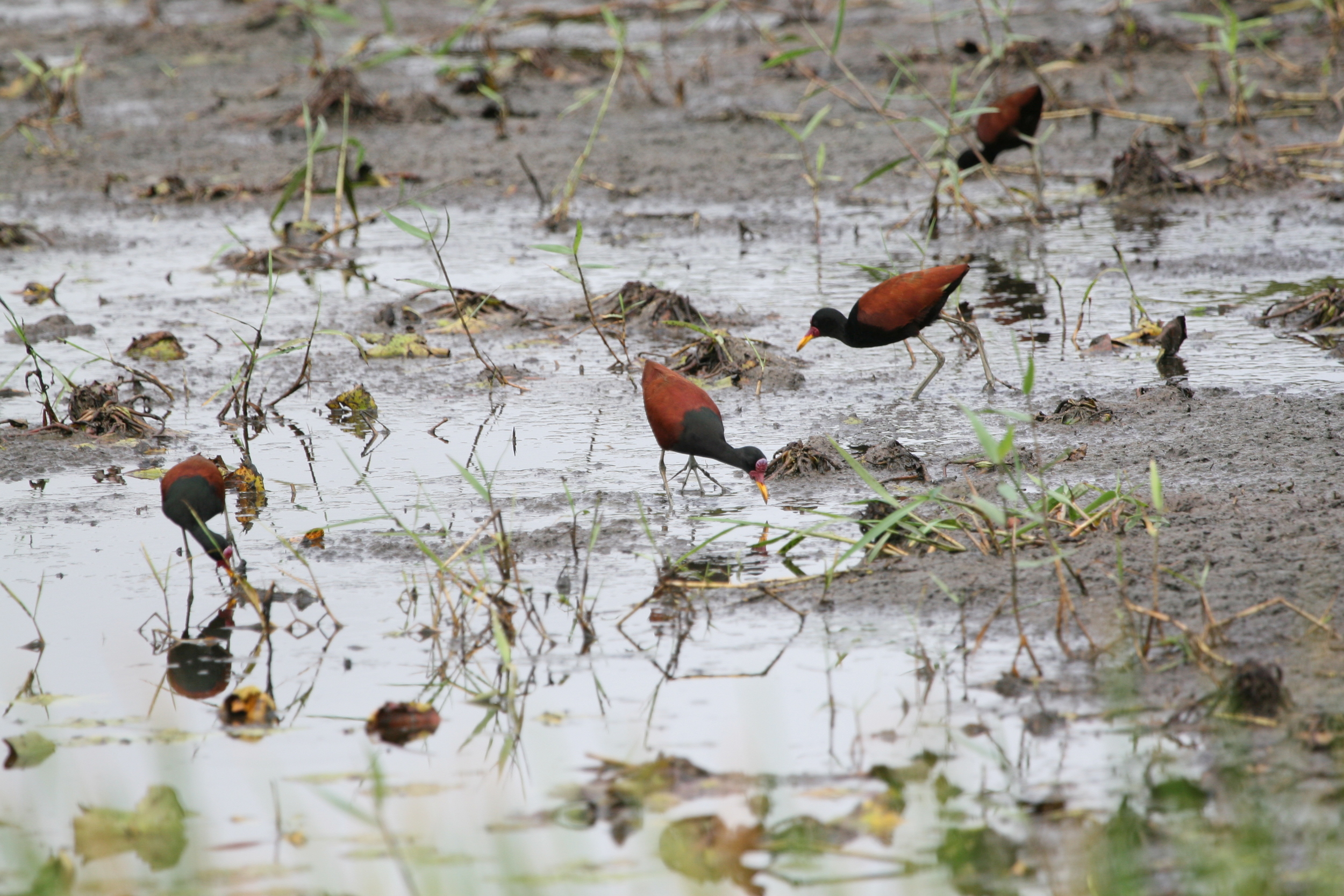
063 Plains-wanderer Pedionomus torquatus
PW was the icing on the cake of one of my best-ever days birding. In terms of waders, that day I had already ticked Australian Pratincole, Little Curlew and Inland Dotterel. I’d also seen Painted Honeyeater, Black Honeyeater, Black-chinned Honeyeater, Brown Songlark, White-backed Swallow, White-winged Fairywren, Regent Parrot and Crested Shrike-tit (what a cast, hey!). It could’ve been even better had I managed to get out of the car in time to see a Barking Owl that raised me from slumber by the side of the road where I had parked up for the night in Chiltern.
Rather than paraphrase, I’ll take up the story from my trip report:
From Chiltern I hit the long stretch through Riverina and the southern edge of the Hay Plain. The drive was enlivened by ABC Grandstand’s Ashes coverage. It had been a close-run thing, choosing this road-trip versus a day at the new Adelaide Oval for an Ashes test in my new home city. But the outback vista, dead straight road, the dryness and the heat outside, and the hissing MW transmission transported me back to the 1970s – when a tranny was what you tuned in to listen to the cricket – and I was happy I’d made the right decision. There was something deeply appropriate about an outback road-trip to the strains of Maxwell, Aggers, O’Keefe et al. Instead of my boyhood hero Dennis Lillee steaming in at the river end at the WACA, this time it was the similarly moustachioed Mitchell Johnson, ripping through the Poms on the flat Adelaide pitch in a spell that – arguably even more than anything he did in Brisbane – set the tone for the 5-0 whitewash. I whooped with delight and punched the steering wheel as wicket after wicket fell with Johnson taking 5-12 in only 3 overs.
I rocked into Deniliquin in the nick of time to hook up with Phil Maher and a tour party. Originally when planning the trip I had contacted his wife Patricia, but was told this weekend was fully booked. As a result I’d made plans to go elsewhere, but when (following a final check) Patricia wrote to me on the first day of the Sydney conference to say that they could just squeeze me in, I reverted to Plan A, cutting my stay at Chiltern to half a day and cutting out Terrick Terrick NP altogether.
…
As the sun tracked to the horizon, we made our way to Robert’s farm where we enjoyed a picnic tea in preparation for the main event. How could there possibly still be a “main event” to come and how could we top the birding we had already enjoyed? Robert’s farm is world famous as the place to see the rare and enigmatic Plains Wanderer, a bird that sits in its own family, neither Quail, nor Button-quail, probably Wader, is small, endangered and is totally dependent on having low, flat, dry plains with just the right amount of low grass and grassy tufts. Too much and it can’t breed (the inland rains of 2010 and 2011 had been the cause of a huge decline in numbers), not enough and it has no shelter from predators. This iconic species was the reason we were all on this trip. With a bottle of James Squires’ 150 Lashes Pale Ale in one hand, and camera in the other, I took my first ever selfie and mused on facebook: “Poms pummelled by Johnson and Warner, and Painted Honeyeater, Inland Dotterel and Australian Pratincole UTB. 150 Lashes in hand as the sun sets over riverina plains. Could my day get any better? It just might…”.
Although PW is not nocturnal, and lives in very sparsely grassed plains, it is cryptically plumaged and almost impossible to see in the daytime when it will sit low in such vegetation there is at the slightest sign of danger. Phil worked out some years ago that the best way to see them was at night when they are less wary and much more easily picked out by spotlight, and it is using this technique that probably 99% of the birders lucky enough to have seen one have succeeded. Once it was dark, then, we set out again in the cars to a field where two weeks previous Jonno Newman had bagged PW as his 7001st world species. Phil’s technique is to drive around with a bright spotlight in hand and hope. Though it seems rather haphazard, it is apparently remarkably effective – within 10 mins the car ground to a halt and he excitedly announced he had a male Plains Wanderer and two chicks. Instantly I was onto them with bins but almost as quickly the chicks melted into the night, presumably hunkering down under the tiny bits of vegetation there. The male stood still in the spotlight and we had crippling views of his intricately patterned feathers as he called softly, keeping tabs on the chicks. We did not spend too long to avoid distress to the chicks but I was able to squeeze off some decent pics nonetheless. As he stared down the barrel of my 100-400L, his puffy cheeks made me think of Chicken Little.
As gorgeous as the diminutive male was, Phil was determined to find a female for us. We spent the next two hours zig-zagging the field. A Fat-tailed Dunnart, a strange looking mouse-like marsupial with, funnily enough, a stumpy fat tail, scampered around barely stopping for a second and never still enough for a photo. Even my record shots are horribly blurred by the combination of low light and moving target from a moving vehicle. Burning the candle at both ends now started to catch up with me: a late night into Chiltern and early start for my Barking Owl dip, not to mention 800km behind the wheel, and I was starting to fade. As Phil carried on quartering the paddock, sweeping back and forth with his torch, my head rocked and rolled, and occasionally jerked back to life. Then my head jerked forward once again as Phil came to an abrupt halt and announced the jackpot! – a female and a male together. Although the male slunk away, Phil kept the torch on the female and she stayed put. You f*@$ing beauty!
We now basked in point-blank views of her: slightly larger, chunkier and more strikingly coloured than the male. She is plain on the back but sports a black and white “choker necklace” above a chestnut cravat, speckled white belly and bright yellow legs. I filled my boots with pictures, bumping up the ISO to compensate for the sensible no-flash rule.
Once Phil decided that she’d been disturbed enough we all piled back into the 4WDs and headed off. Barely a few minutes later as we headed for the gate Phil stopped again – he had another two males in his spotlight by the side of the car. Wow! In all seven Plains Wanderers, the most Phil had had in a few years.
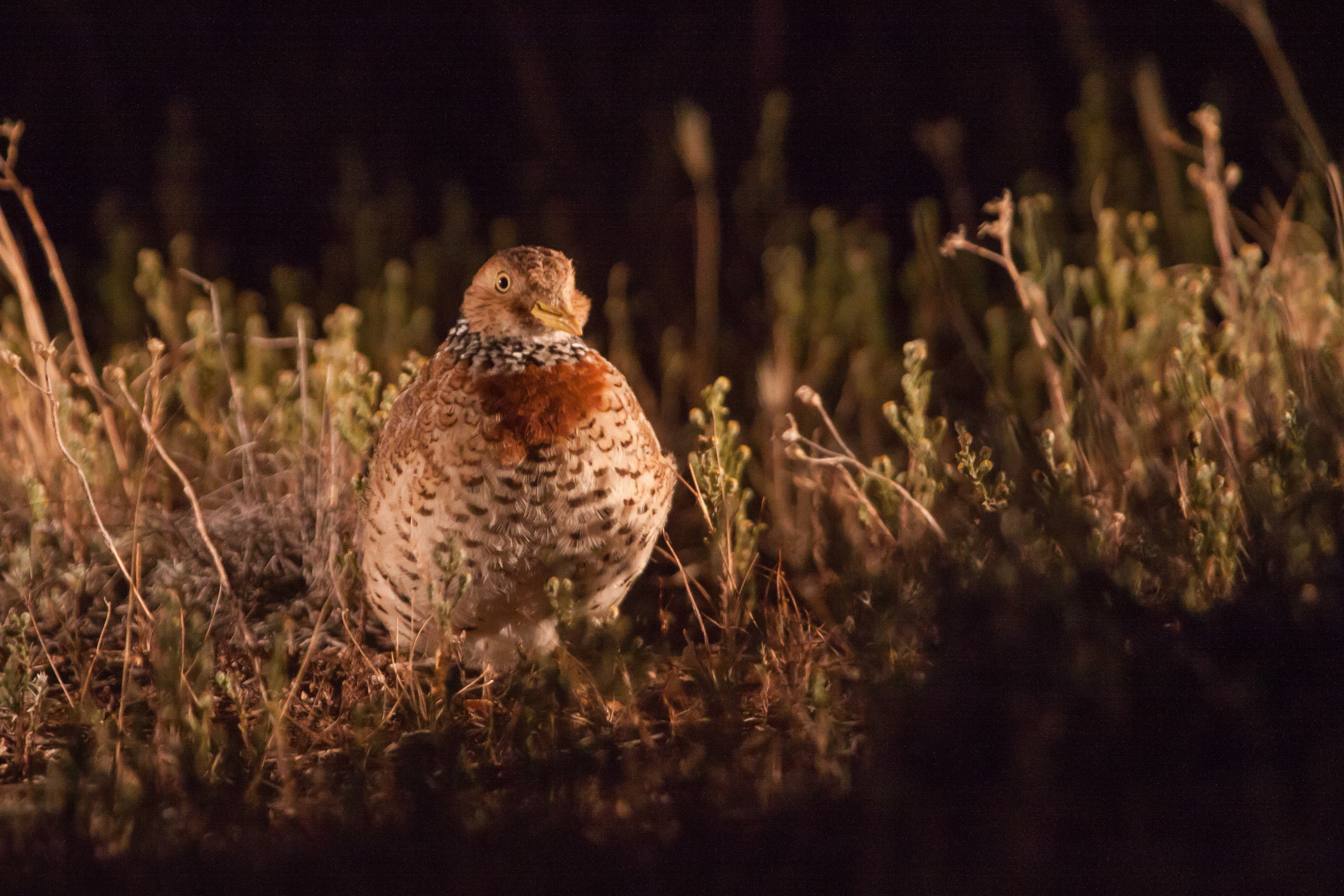
064 Grey-breasted Seedsnipe Thinocorus orbignyianus
A superb wader that I have very little to say about, because it was totally overshadowed by DSP. Like the latter they live in high Andean grassland. The day before ICCV started I went up to the Yeso Valley with Ryan Falkner (a fellow Computer Vision birder) with our guide Rodrigo (Albatross Birding), and we had an utterly superb day. We saw a few GBSS, which typically posed nicely on the top of rocks and posts. Grey-breasted remains the only one of the four in this South American family I have seen.

065 Upland Sandpiper Bartramia longicauda
Disappointingly, I do not have an image of Upland Sandpiper. My lifer came during a mega-twitching week in November 2005. There must’ve been a weather system because there were some great North American vagrants that late autumn. Early in the week I managed to clear my diary and bagged a Grey-cheeked Thrush in the next county, Hertfordshire. I had to go further afield for the Upland Sand, to Kingston Seymour in Somerset and Bristol. I don’t recall a lot about this twitch other than being pushed for time; I rarely twitched without being pushed for time in those days, a combination of work and very young kids! It involved a tricky and time-consuming drive to the coast once I’d left the M5 (this was in the days before I had a SatNav!), and then a fairly long walk along the sea wall for distant views of the transatlantic mega-rarity. I guess I had scope with me but no digiscoping kit. Or if I had the latter the pics were so bad that I didn’t keep them.
I had a chance to rectify this in August 2011 when we had a family holiday visiting friends in Toronto and I snuck in a day’s birding at the Carden Alvar Important Bird Area, about 90mins north of their place in Whitby. The whole area is a superb and fairly rare habitat of limestone grasslands that is attractive to a variety of cool North American species. I was too late in the year for the best chance of my main target (the increasingly rare Golden-winged Warbler), and I dipped, but I did have nice encounters with other targets including Sedge Wren and Eastern Bluebird. I found two sets of Upland Sandpipers, a group of four, and then a pair. Unaccountably I have not even a record shot, just a vague memory and a note in my day list. What was I thinking?!
066 Eurasian Whimbrel Numenius phaeopus
Seen in various places in the UK, but I have no image of one. And though I am sure it is on my Oxon list, I don’t actually recall any particular occasion when I saw one in my home county. I do know that I saw one most recently in 2019 on a trip to Dawlish Warren with Steve, when we saw a few distant birds from the hide.
067 Hudsonian Whimbrel Numenius hudsonicus
I have seen Hudsonian Whimbrel in the States, including on my SoCal trip in 2011, but this image is from the coast near Santiago. I hired a car and spent a day birding along the coast between Concon and Valparaiso. My main target that day was Inca Tern, and I did manage to see large numbers of the stunners, and get great photos, but these came at a price; while photographing a particularly close bird my camera bag was swiped from the back of the car. Of course it didn’t have my camera in it, and fortunately not my passport, but it had other birding equipment including optics, memory cards, flash gun, torch, etc.
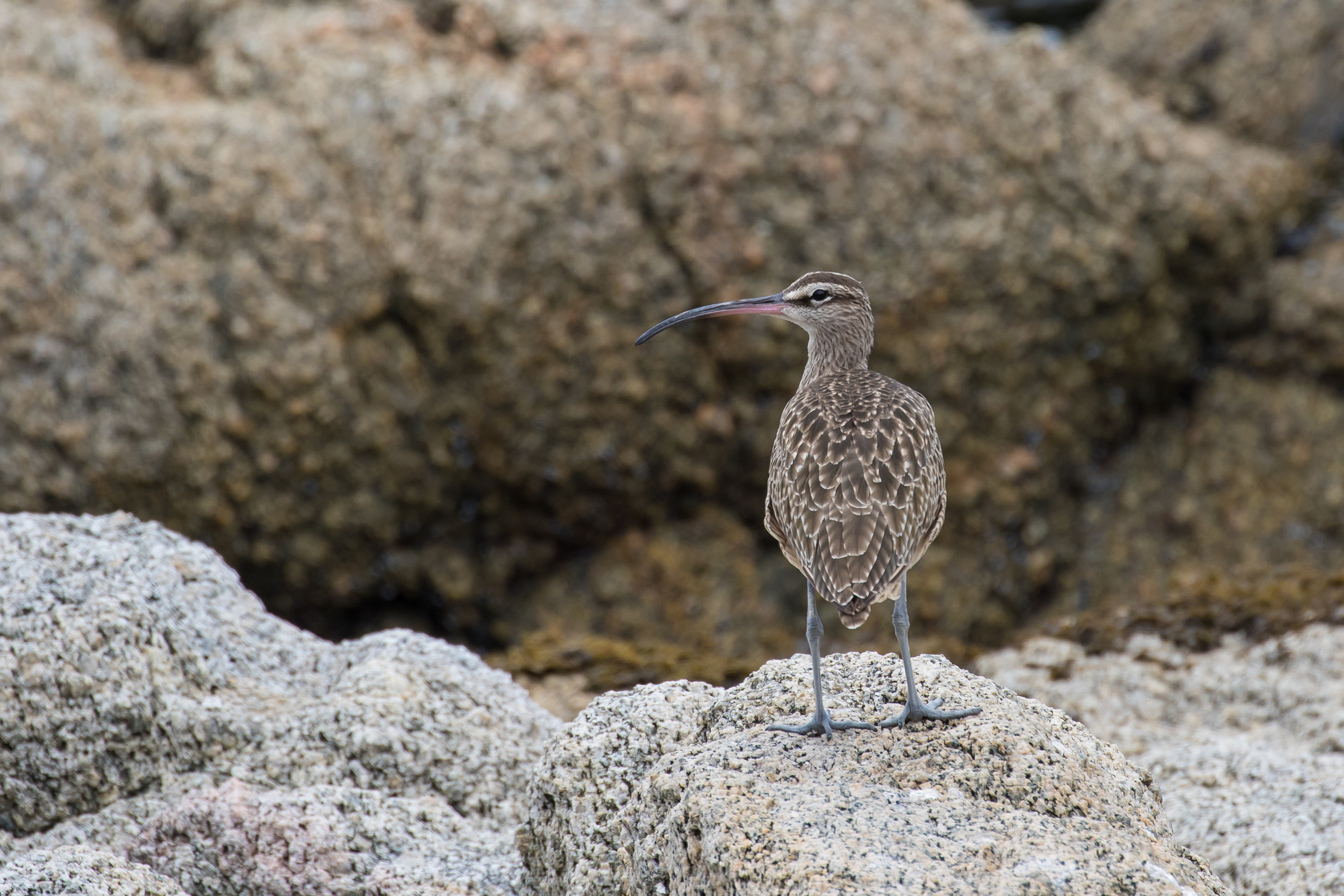
068 Little Curlew Numenius minutus
Little Curlew was one of the lifers I had on my Plains-wanderer day/evening in Deniliquin. It was distant and this image is a still grabbed from a digiscoped video. I few years later one appeared at Bald Hill Beach on a Saturday morning, right in front of birding pals Paul, Sam and Chris. I had been on school sport duty, and didn’t actually look at my messages until it was too late to get there at a sensible time for the tide. Instead I waited until the evening tide and dipped. I then couldn’t go early Sunday when it was seen by a few more of the Adelaide birding community, but I managed to clear my Monday morning diary for another crack at dawn high-tide… and dipped again.
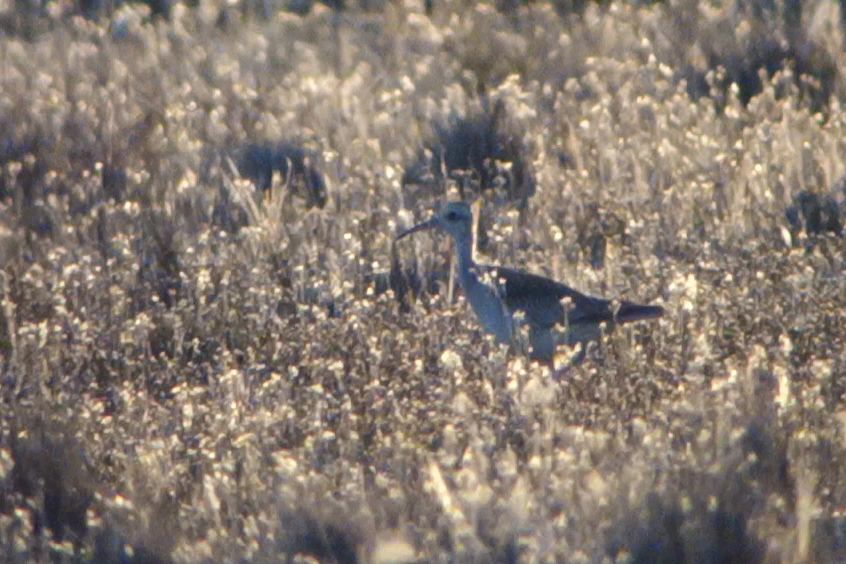
069 Long-billed Curlew Numenius americanus
No great memories of this, but I did tick it off in a field near a prison close to the Salton Sea. Salton Sea really was a pretty desolate, even ugly place, but it was superb for birding. I’d just seen Roadrunner, and was searching for Longspurs, hoping some were still l hanging around before heading north to breed. I have a couple of awful record shots to prove it, though given this is the best of them you can see how bad the others are!
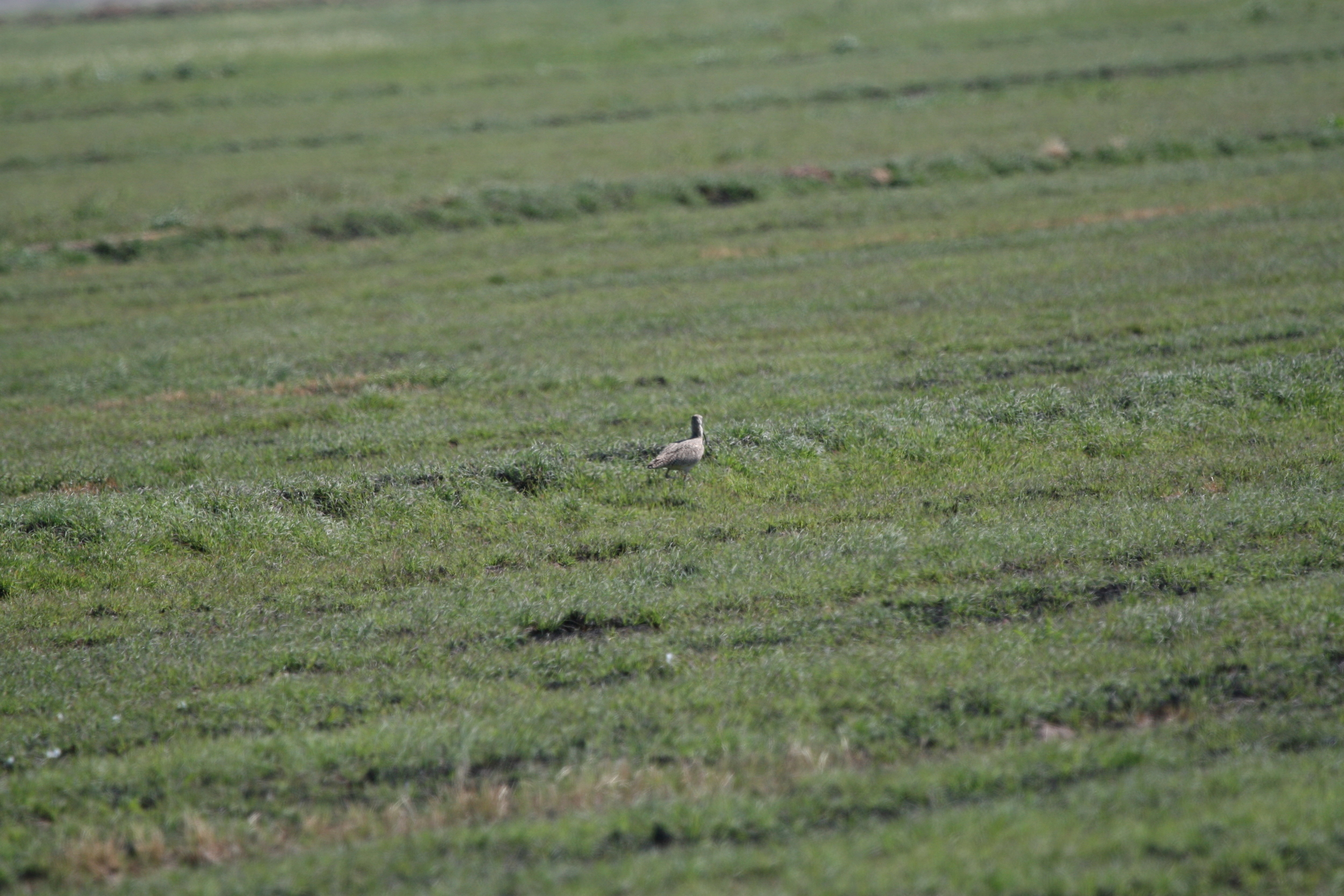
070 Far-Eastern Curlew Numenius madagascariensis
You don’t often get a lifer on a twitchathon. But at the end of one of our worst runs, Paul Coddington, Ady James and I stopped the clock at the northern part of Thompson Beach then drove the 5mins or so to the southern end. A lone Far-Eastern Curlew was distant but tickable, so made it only my life but not my day list! Like many of the migratory wading birds of the eastern flyway, their numbers have been decimated in recent years, victims of the economic miracles that are modern day Korea and China that have seen mudflats, essential for the birds to refuel en route, filled in and converted for housing, industry and agriculture. Annoyingly I do not have a photo, and this summer 19/20 I didn’t even make it up to places like Thompson or Bald Hill where I might have a decent chance of breaking my duck.
Postscript: a late addition to the photographed list. I thought I had misse dthe boat for a pic in 2020, but then saw on FB “South Aussie Birding” that ther were potentially some overwintering curlew at the head of eh gulf this autumn. With lockdown restrictions easiing, I jumped in the Kluger on Sunday afternoon to try to connect with high tide at Bald Hill Beach. A very tidy 30mins on Mail Rd yielded 4 Wedge-tailed Eagles (I’d not previously seen one at this site), 6 Whistling Kite, 2 Brown Falcons and a Black Falcon, (earlier I’d seen Nankeen Kestrel, Black Kite and Black-shouldered Kite as well) so not a bad raptor list. I got to Bald Hill at about 4pm and hour before dark and later than I had planned because the tide was right in. Wit the tide so high there was very limited roosting space near where the track emerges to the coast and I found only 3 waders: two Pied Oystercatchers and a one Far-eastern Curlew. Duck broken!

071 Eurasian Curlew Numenius arquata
The song of Eurasian Curlew is a haunting warble, intimately associated with moorland in the spring and summer. I have seen lots, most memorably one summer evening at Lochindorb when a pair wheeled above my head in stunning highland scenery. But I was amazed to discover that I have almost no photos. Hunting through the archives I finally came across this really awful record shot which I took with primitive digiscoping equipment in 2004 at Minsmere, because at the time there was a suspicion that it was something much rarer.
It was early October 2004, just two days before we were due to travel to Australia for 3 months’ sabbatical. Word broke that the there was a putative Slender-billed Curlew at Minsmere; I was panicked. I had turned down the chance to see the Druridge Bay bird in ’98. I really should have arranged to be ill that afternoon, but I was good, gave my lecture, and Steve Young drove straight past Oxford on his way north with a spare seat in his car. However improbable that a second instance of the world’s most critically endangered wader might show up on the east coast, I had to try and connect. Nikki, at home with a 1 and 3 year old, needed the car and forbade me from going. Fortunately, though, her sister (much to Nikki’s disgust) was more understanding and lent me her work vehicle. So it was that around 8am Saturday morning I arrived in a flower delivery van in the carpark next to the Sizewell nuclear power station.
I trudged along the beach for a mile to view the fields south of the main RSPB Minsmere reserve (this was quicker than going through the reserve, and bypasses the problem that the reserve proper does not open until 9am). The bird was showing very distantly and immediately stood out as much smaller than the 3 Curlews it was loosely hanging about with, and with a slightly different feeding pattern. At the time I thought I could make out heart-shaped markings on its flanks, which is one of the field-marks that distinguishes SBC from EC, which has arrow-head flank marks (though my shot below suggests the marks are somewhat intermediate). This was all very exciting, and the rumour-mill was in full swing. Apparently Didier Vangeluwe, allegedly a “world expert on SBC” had seen the bird yesterday and declared a belief that it was good. I left later that day having secured views that would satisfy me if the expert opinion landed on the favourable but unlikely identification. We were already in Australia when sadly it was proven to be an aberrant curlew by DNA analysis of some of its excrement. Unsurprisingly, Didier also ended with some egg on his face and reputation as “world expert” somewhat diminished.
It wasn’t a totally wasted trip though. I had seen my second British Black Restart on the walls of the Sizewell power station as I walked along the beach, and I also ticked off Baird’s Sandpiper which was on one of the scrapes to the north, also being twitched by the hordes. And finally, I did, as you can see, bag my only photos to date of Eurasian Curlew.

072 Bar-tailed Godwit Limosa lapponica
One of the first waders I ever ticked off. These are – or at least used to be – one of the more conspicuous and common waders of the Swan Estuary, so Barwit was one of the 100 or so species I noted in my 1994 quest to grip off Youngster. I’ve never seen one in Britain, though only a few weeks back Oxon birding buddy Tom Bedford had a flyover of 4 while out birding his local patch in suburban Oxford. In SA they are mainly seen north of Adelaide on the Gulf coast at places like Thompson’s Beach and Bald Hill Beach. They’re not so easy to get close to, so I don’t have many good pics. The four pictured here were at Port Clinton just around the head of the Gulf, one autumn morning when Paul Coddington and I walked barefoot out onto the mudflats and photographed knots, stints and little terns. There are four barwits here, along with a Red Knot, Curlew Sanpidpiper (see far left) and a Red-necked Stint.
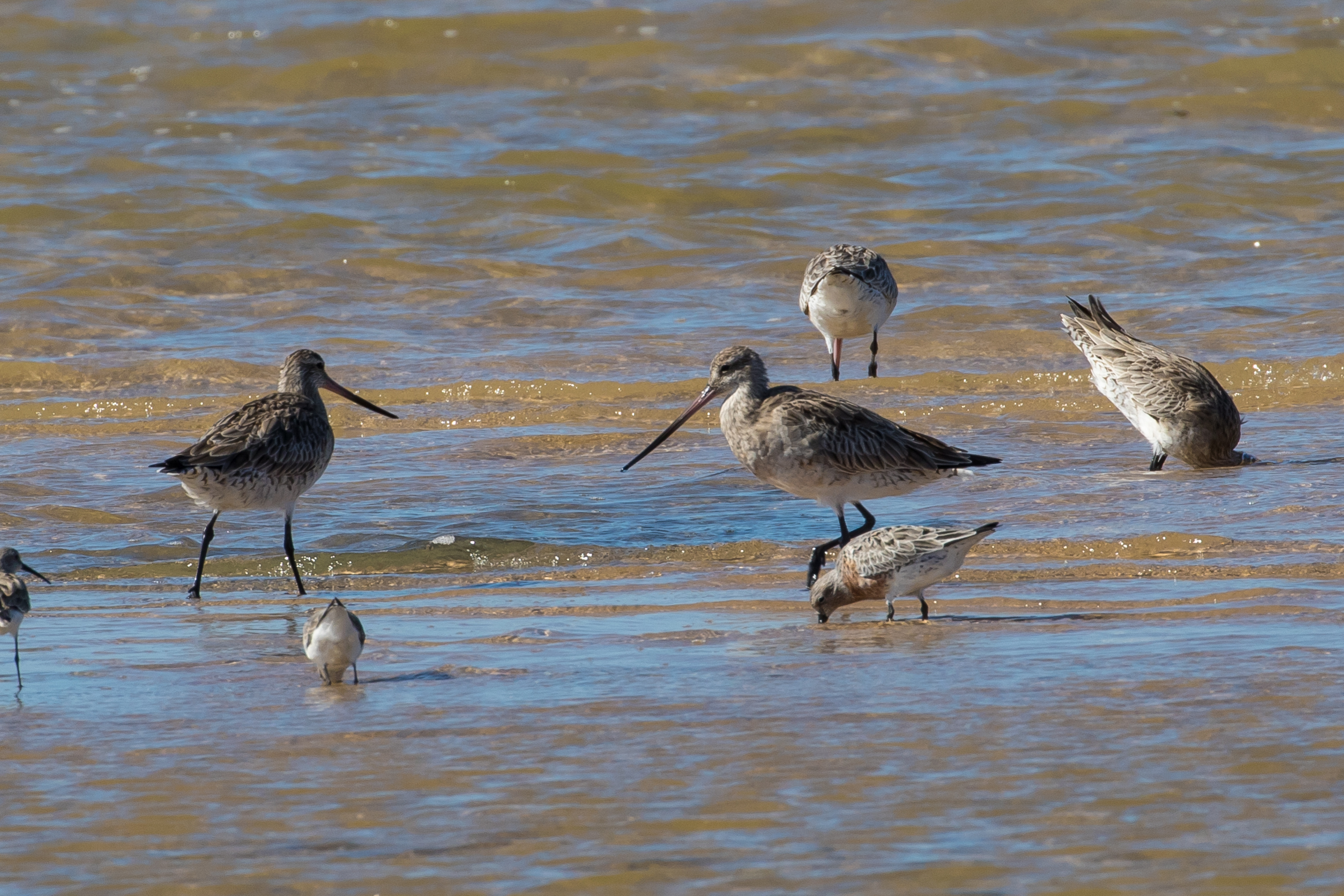
073 Black-tailed Godwit Limosa limosa
My first memory of Black-tailed Godwits is a bit hazy. I have a feeling it was on the Exe Estuary with Steve and Penny, an afternoon and evening that I recall better for the excellent pints of Abbott we shared at the Double-locks on the Exeter Ship Canal. They are rather rarer than Barwits in SA but I’ve seen a few: one at Magazine Rd wetlands and a couple at Tolderol last year. And then today (10/5/20 as I write this), while searching for a decent photo of Banded Stilt for an earlier post in this series, I found 6 Blackwits at St Kilda, including one in breeding plumage. I guess he didn’t get out of the country in time before ScoMo restricted international travel because of Covid-19 ;-). The bird pictured was photographed at the Dubai Pivots on my 2013 stopover.
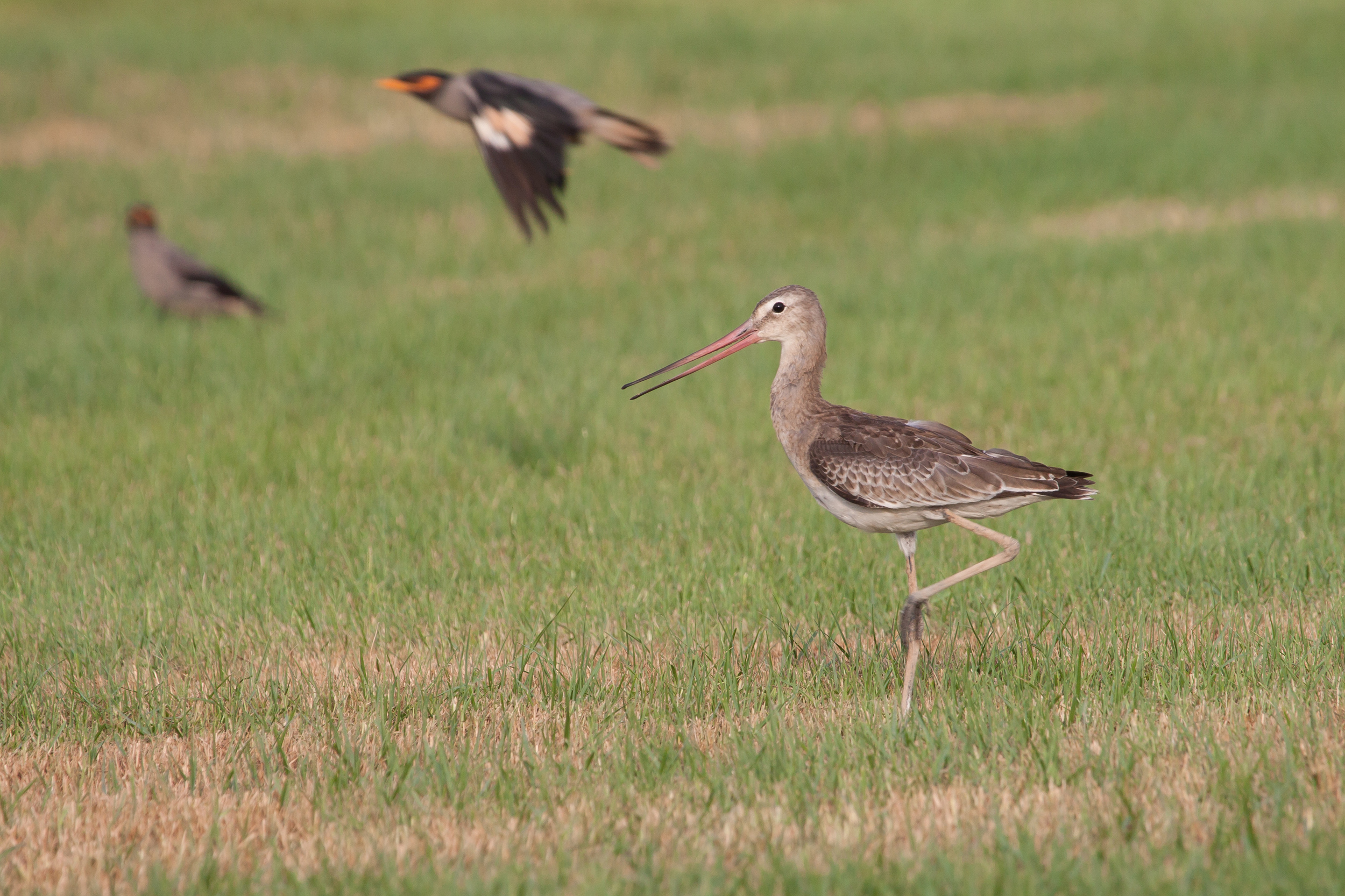
074 Marbled Godwit Limosa fedoa
No picture. A target for the next trip to NA, whenever that will be. Was supposed to be next month :-(.
075 Ruddy Turnstone Arenaria interpres
I saw these first in Perth, but have also seen them in UK. Almost strictly coastal the best local sites are (as for other coastal waders) Thompson’s and Bald Hill beaches. By rights I should have much better pictures than I do, so maybe this is also e to work on, because they are very beautifully patterned.

076 Black Turnstone Arenaria melanocephala
I’ve already described how I came unexpectedly to be in Santa Barbara in March 2011 – my Romanian student’s visa failed to materialise so I had to travel to deliver our paper. One morning before the conference session I went out early to the marina. Black Skimmers were roosting on the beach near the jetty, various sea interesting waterbirds were either in the calmer waters of the marina or just outside including Western Grebe, Surf Scoter, Brown Pelican and Red-throated Loon (Diver), but I was particularly after Black Turnstone and Surfbird which my research said loved to scuttle about on the rocks of the breakwater. My gen was not wrong for the former – a found a couple of birds including the one pictured – but I dipped on Surfbird.
